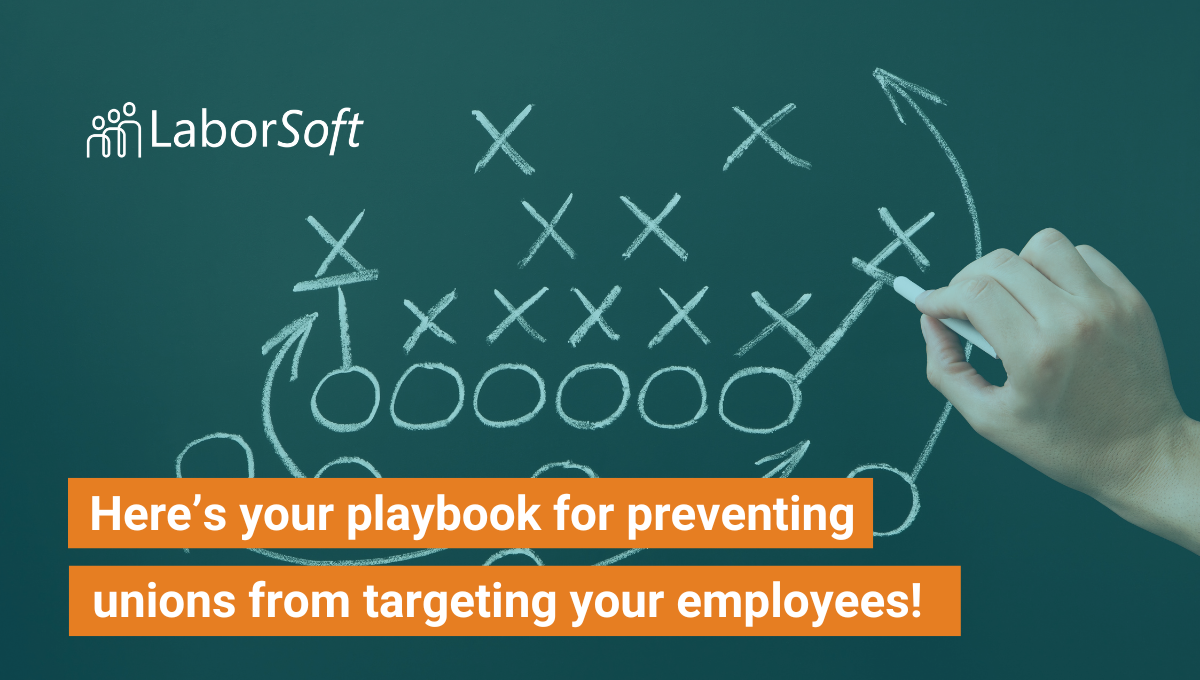How Unions Target Your Company's Unsatisfied Employees
Read Time 5 mins | Oct 8, 2023 | Written by: Frankie Kourtis

Worried about unionization of employees?
Today’s companies, and particularly HR departments, need to be conscious of employee satisfaction while on the job. Competitive compensation alone doesn’t guarantee a happy and engaged workforce. Rather, working conditions, management misconduct, and growth opportunities all contribute to employee morale – and can have a significant impact on whether or not employees attempt to unionize.
Labor drives over the last few years have caught a lot of attention, but the truth is that unionization rates in the U.S. remain far lower than half a century ago. Overall, only 6% of the private sector workforce currently belongs to a union (per Gallup), although approval of labor unions is currently 71% in the U.S., higher than at any time since 1965.
Many companies “at risk” of unionization can still successfully circumvent this eventuality with a proactive and understanding approach to employee relations and labor relations. If you're able to address issues before they become a cause of contention, you may see employees pull back from organizing.
6 Common Issues That Make You a Target for Unionization
1. Abusive treatment by management or supervisors
Managers and supervisors set the mood in the work environment, and negative social behaviors can create a toxic, abusive culture. A pattern of abusive management can look like a lot of things, including blaming workers to save face, taking anger out on others, breaking promises, not giving credit to workers, making negative comments in front of others, invading worker privacy, ridicule, and more. Research has shown that abusive supervision is underreported, likely due to a fear of reprisal after exposing the abuse. An ongoing pattern of abusive treatment may encourage workers to turn to unions as their only avenue for help and support.
2. Workplace safety and compliance concerns
The safety of your workers is of paramount importance, and a perceived unsafe or non-compliant environment can encourage workers to turn to unions for protection. The data shows that safety indeed tends to increase with union involvement.
The disparity in safety between union and non-union construction worksites is substantial. A recent report from the Illinois Economic Policy Institute, which is based on publicly reported OSHA data, found that a union worksite was 19% less likely to have safety violations than a non-union site. Furthermore, union worksites had 34% fewer violations per OSHA inspection.
If workers suspect your business to be skirting compliance issues or giving less than your full attention to workplace safety, this is an invitation for employees to look for enforcement from somewhere else.
3. Lack of communication or responsiveness to HR issues
There are many potential costs of ignoring employee complaints until it's too late. One of them is unionization. It's imperative that HR leaders put work into taking a frequent pulse of employee satisfaction, employee engagement, and the employee experience. Surveys on a regular basis can be a good place to start. Communication and really listening to employees can go a long way towards providing the insights you need to avoid union action. Always resolve HR issues promptly to reassure employees that their best interests are a top priority.
4. Job security and promotional opportunities
Amazon union organizers in Alabama complained of "no sense of job security" as they headed towards union elections. Workers want to feel valued and important to the company's plans, and a sense that they are expendable or replaceable - perhaps communicated outwardly, or perhaps suggested by leadership's actions in the workplace - can encourage unionization. An achievable and real slate of promotional opportunities is an important path to provide to your workers.
Also beware of the observed trend of "quiet promotions", which are not true promotions and won't keep workers satisfied. Additional work responsibilities without a new title or additional compensation will instead foment unrest.
5. Inequality and discrimination in the workplace
The workforce today places a high value on inclusivity and diversity. Be vigilant about workplace harassment and how it can impact overall DEI objectives. A business that allows inequality and discriminatory decisions to influence the work environment will find itself on the path towards high turnover, serious legal trouble, and the potential for a unionization movement.
6. Financial disparities for similar positions
One of the professed functions of workers' unions is to reduce income inequality in the economy at large. However, wage inequality between two employees who work in similar roles can also put your business at risk of poor employee relations and growing unrest. Sharing salary information is protected under the National Labor Relations Act, and more workers today than in past decades are willing to break the salary sharing taboo. Young workers aren't keeping their salaries a secret anymore, in part to see if they're earning their fair share compared to peers. It's best to regularly review salary data within your workforce and ensure that financial disparities are not so pronounced or arbitrary as to provoke a union movement.
How to Address HR Grievances Effectively
Union avoidance is possible if you can convince your workforce of imminent change. In addition to addressing immediate issues, it's legal and fair to share the less appealing attributes of union participation: monthly dues and stipends to a union (which is typically deducted from their paycheck); the potential for picketing and strikes which is unpaid and can result in lack of salary for weeks at a time; and that collective bargaining may prove unfavorable as there are no guarantees despite organizing or participating in a union.
Companies are also encouraged to accentuate the positive aspects of the current working environment including compensation and benefits, and promoting a more open and communicative workplace for all. An independence and individuality that can be threatened by union guidelines.
LaborSoft, the leading partner for HR Case Management technology, provides union avoidance resources for businesses. Plus, our innovative system provides the capabilities, intelligence, and flexibility companies need to oversee today’s employee and labor relations issues that can lead to unionization.
Through an engaging, user-friendly interface with point-and-click features, we make it easy to store, search, and archive case-related information. LaborSoft’s documentation, tracking, and reporting ensures HR grievances are facilitated quickly and accurately to save your company time and money managing HR investigations.
Contact us for a customized demonstration and learn how LaborSoft can help you improve communications, build a more collaborative, safe, and supportive workplace, and reduce the likelihood of unionization.
This blog was orignally published on 2/22/18 and updated on 10/8/23.



